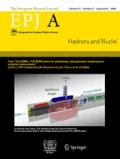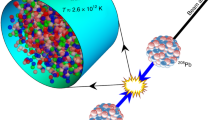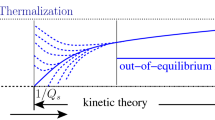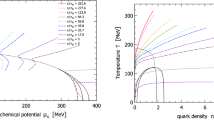Abstract.
We can establish a new picture, the perfect fluid sQGP core and the dissipative hadronic corona, of the space-time evolution of produced matter in relativistic heavy-ion collisions at RHIC. It is also shown that the picture works well also in the forward rapidity region through an analysis based on a new class of the hydro-kinetic model and that this is a manifestation of the rapid increase of the entropy density in the vicinity of QCD critical temperature, namely, deconfinement.
Similar content being viewed by others
References
http://www.bnl.gov/bnlweb/pubaf/pr/PR\_display.asp ?prID=05-38.
P. Huovinen, in Quark Gluon Plasma 3, edited by R.C. Hwa, X.N. Wang (World Scientific, 2004) p. 600
STAR Collaboration (K.H. Ackermann ), Phys. Rev. Lett. 86, 402 (2001)
PHENIX Collaboration (K. Adcox ), Phys. Rev. Lett. 89, 212301 (2002)
PHOBOS Collaboration (B.B. Back ), Phys. Rev. Lett. 89, 222301 (2002)
BRAHMS Collaboration (H. Ito), talk given at the 18th International Conference on Nucleus-Nucleus Collisions, Quark Matter 2005 (QM 2005), Budapest, Hungary, 4-9 August 2005.
C. Nonaka, S. Bass, nucl-th/0510038. (This paper employs different hydrodynamic and hadronic cascade codes from the present paper.)
See, for example, F. Karsch, Lect. Notes Phys. 583, 209 (2002).
PHENIX Collaboration (K. Adcox ), nucl-ex/0410003. %%CITATION = NUCL-EX 0410003
T. Hirano, M. Gyulassy, nucl-th/0506049.
T. Hirano, K. Tsuda, Phys. Rev. C 66, 054905 (2002). %%CITATION = NUCL-TH 0205043
T. Hirano, Y. Nara, Nucl. Phys. A 743, 305 (2004). %%CITATION = NUCL-TH 0404039
Y. Nara, N. Otuka, A. Ohnishi, K. Niita, S. Chiba, Phys. Rev. C 61, 024901 (2000).
T. Hirano, Phys. Rev. C 65, 011901 (2002)
T. Hirano, Phys. Rev. Lett. 86, 2754 (2001). %%CITATION = NUCL-TH 0004029
Recently, the effect of event-by-event fluctuation in the initial conditions is found to reduce $v_2$ in forward and backward rapidity regions. It is concluded that a lack of thermalisation is not needed when fluctuation is taken into account: R. Andrade, F. Grassi, Y. Hama, T. Kodama, O. Socolowski jr., B. Tavares, nucl-th/0511021.
T. Hirano, U. Heinz, D. Kharzeev, R. Lacey, Y. Nara, nucl-th/0511046.
One can find many papers in these proceedings for recent progress to understand non-equilibrium aspects of gauge theories and an initial prethermalisation stage in relativistic heavy-ion collisions.
P. Kovtun, D.T. Son, A.O. Starinets, Phys. Rev. Lett. 94, 111601 (2005)
Author information
Authors and Affiliations
Corresponding author
Rights and permissions
About this article
Cite this article
Hirano, T. What can we learn from hydrodynamic analysis at RHIC?. Eur. Phys. J. A 29, 19–22 (2006). https://doi.org/10.1140/epja/i2005-10291-y
Received:
Accepted:
Published:
Issue Date:
DOI: https://doi.org/10.1140/epja/i2005-10291-y




